人教版七年级上册Unit 4 Where's my schoolbag?Section A(2d – 3c)课件(共25张PPT)
文档属性
| 名称 | 人教版七年级上册Unit 4 Where's my schoolbag?Section A(2d – 3c)课件(共25张PPT) |  | |
| 格式 | ppt | ||
| 文件大小 | 9.3MB | ||
| 资源类型 | 教案 | ||
| 版本资源 | 人教新目标(Go for it)版 | ||
| 科目 | 英语 | ||
| 更新时间 | 2022-09-21 10:20:05 | ||
图片预览

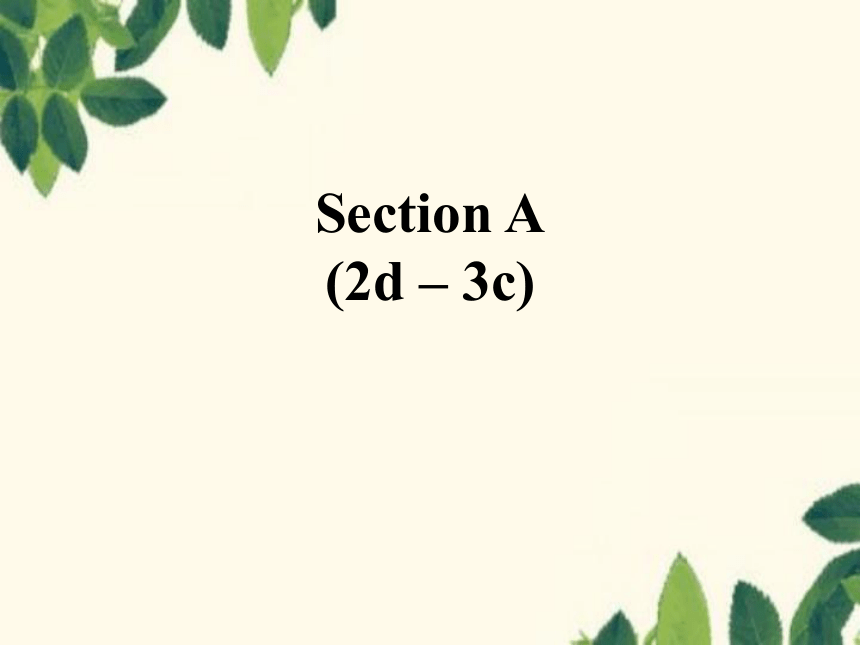
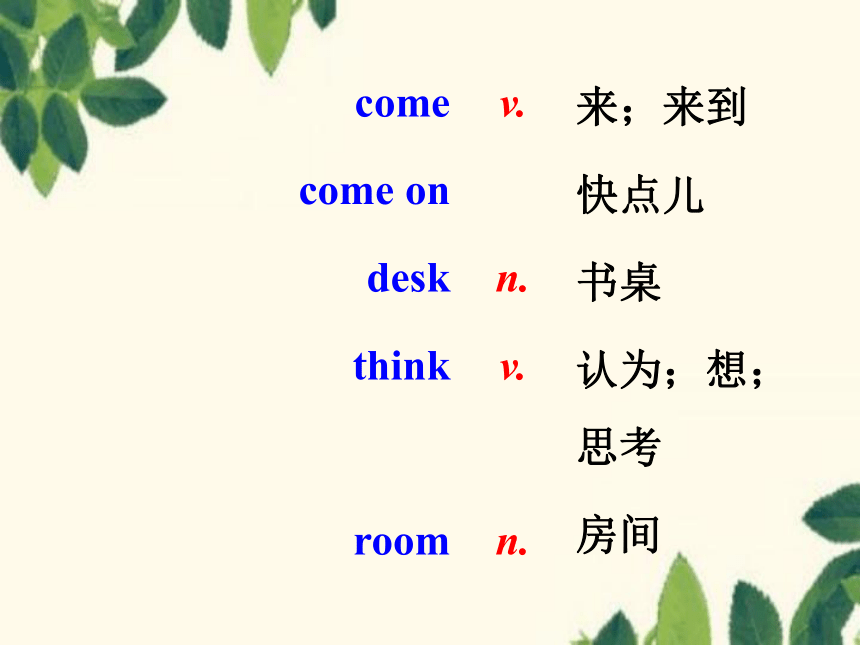


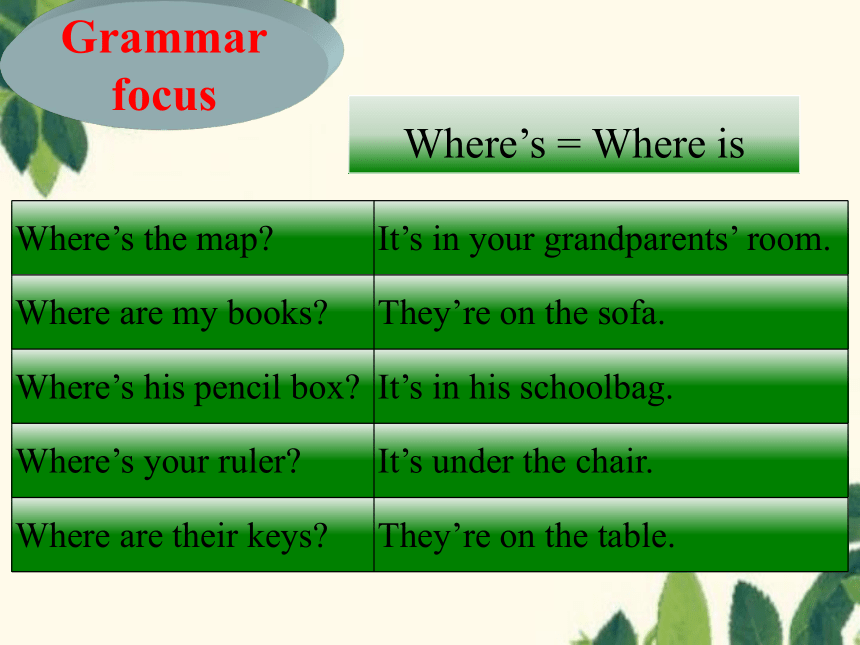
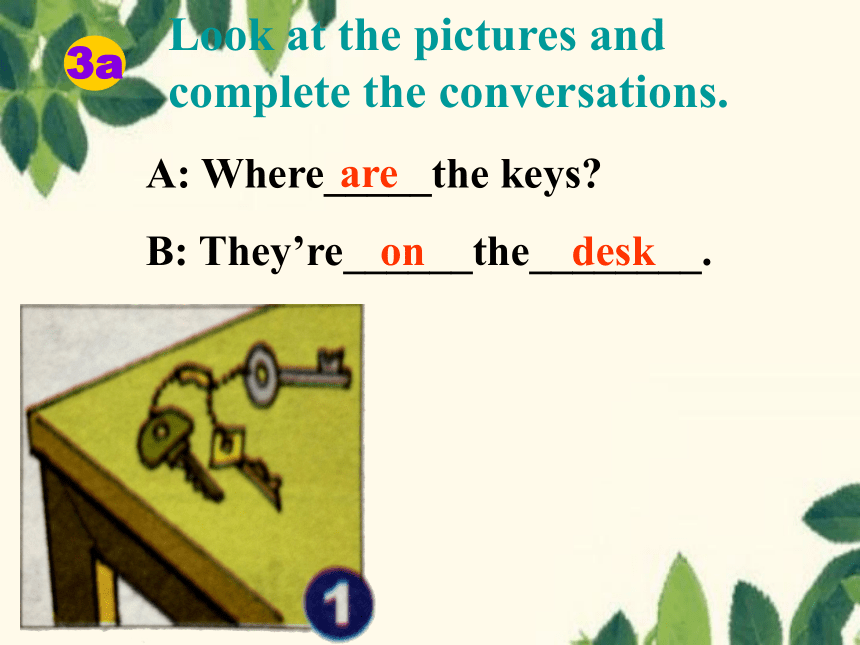

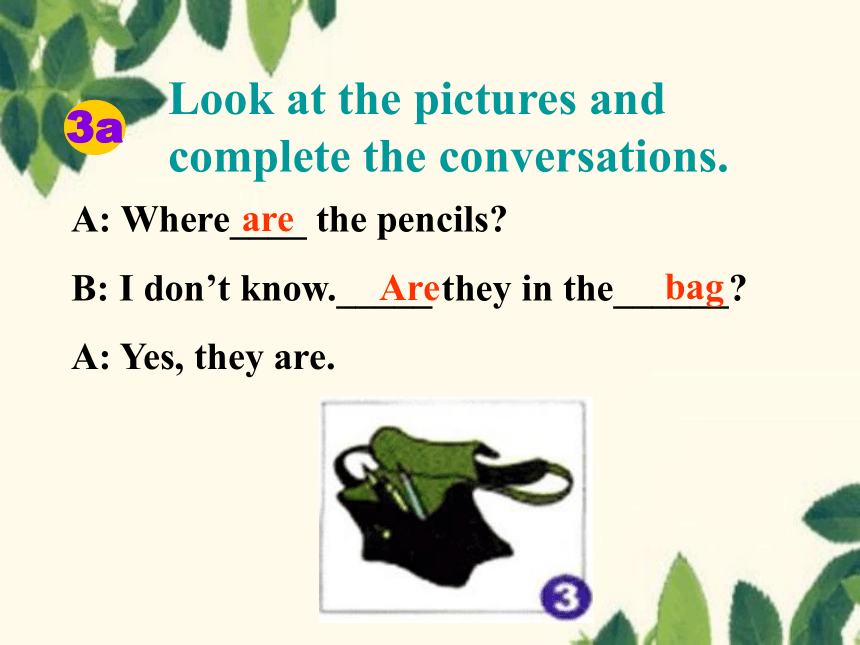
文档简介
(共25张PPT)
Unit 4
Where’s my schoolbag
Section A
(2d – 3c)
come
come on
desk
think
room
v.
n.
v.
n.
来;来到
快点儿
书桌
认为;想;思考
房间
their
hat
head
yeah
know
pron.
n.
n.
interj.
v.
他(她、它)们的
帽子
头
是的;对
知道;了解
Role-play the conversation.
2d
Mom: Come on, Jack!
Jack: Oh, no! Where’s my bag
Mom: Hmm…is it on your desk
Jack: No. And it’s not under the chair.
Mom: Oh! It’s on the sofa.
Jack: Thank you, Mom. Err…where’s the map
Mom: I think it’s in your grandparents’ room.
Jack: Yes, it’s on their bed! And my hat
Mom: It’s on your head!
Jack: Oh, yeah! Haha!
Grammar
focus
Where’s the map It’s in your grandparents’ room.
Where are my books They’re on the sofa.
Where’s his pencil box It’s in his schoolbag.
Where’s your ruler It’s under the chair.
Where are their keys They’re on the table.
Where’s = Where is
Look at the pictures and complete the conversations.
3a
A: Where_____the keys
B: They’re______the________.
are
on
desk
A: Where’s the______ ____ it on your desk
B: No, it’s_______the chair.
book
Is
under
Look at the pictures and complete the conversations.
3a
A: Where____ the pencils
B: I don’t know._____ they in the______
A: Yes, they are.
are
Are
bag
Look at the pictures and complete the conversations.
3a
Ask and answer questions about the things on the right.
3b
Student A, look at the picture on page 19. Student B, look at the picture on the right. Ask and answer questions to find the differences.
3c
A: Where’s the schoolbag Is it under the table
B: No, it isn’t. It’s on the table.
End
1. come v.来;来到
此动词不能接宾语,如果接地点名词的话,则构成come to +地点名词,如:come to the classroom(来教室);如果后接地点副词的话,则直接放在其后,如:come here(到这儿来)。
BACK
BACK
3. hat n.帽子
(指的是四周都有沿的帽子,如礼帽、草帽、太阳帽等)
1. Come on,Jack!快点儿,
杰克!
(1)表示请求、鼓励、劝说等,意为“来吧;行啦”。
Come on, Lucy, come on. Don’t be so shy. 来吧,露茜,来吧,别不好意思。
(2) 用来催促别人快走(做),意为“快点”。
Come on, it’s getting dark. 快点,天要黑了。
(3) 用于体育竞赛等场合鼓励队员,意为“加油”。
“Come on! Come on!” shouted the audience again and again.“加油!加油!”观众一再地喊。
BACK
2. I think it’s in your grandparents’ room. 我认为在你祖父母的房间。
I think 常用来表达某人的观点或看法,后面接一个句子(宾语从句)。
I think this is Tom’s watch. 我认为这是汤姆的手表。
如果后面的宾语从句要表示否定意义时,在形式上应该否定前置。
I don’t think this is Tom’s watch. 我认为这不是汤姆的手表。
BACK
3. — Where are their keys 他们的钥匙在哪儿?
— They’re on the table. 它们在桌子上。
回答where的问题时,要注意使用正确的人称代词,因为英语的习惯表达是:问句用名词,答句常用主格代词,所以这里的their keys的主格代词是they(复数形式)。
— Where are your friends 你的朋友们在哪里?
— They’re in the classroom. 他们在教室里。
BACK
4. I don’t know. 我不知道。
本句话是带有实义动词know的否定句,其中的don’t是do not的缩写,do为助动词,没有实际意义,不能与be动词搭配使用;
即be动词(am, is, are)不能与助动词do搭配使用,也不能与实义动词原形搭配使用。
I know his name. 我知道他的名字。
I don’t know his name.
BACK
Unit 4
Where’s my schoolbag
Section A
(2d – 3c)
come
come on
desk
think
room
v.
n.
v.
n.
来;来到
快点儿
书桌
认为;想;思考
房间
their
hat
head
yeah
know
pron.
n.
n.
interj.
v.
他(她、它)们的
帽子
头
是的;对
知道;了解
Role-play the conversation.
2d
Mom: Come on, Jack!
Jack: Oh, no! Where’s my bag
Mom: Hmm…is it on your desk
Jack: No. And it’s not under the chair.
Mom: Oh! It’s on the sofa.
Jack: Thank you, Mom. Err…where’s the map
Mom: I think it’s in your grandparents’ room.
Jack: Yes, it’s on their bed! And my hat
Mom: It’s on your head!
Jack: Oh, yeah! Haha!
Grammar
focus
Where’s the map It’s in your grandparents’ room.
Where are my books They’re on the sofa.
Where’s his pencil box It’s in his schoolbag.
Where’s your ruler It’s under the chair.
Where are their keys They’re on the table.
Where’s = Where is
Look at the pictures and complete the conversations.
3a
A: Where_____the keys
B: They’re______the________.
are
on
desk
A: Where’s the______ ____ it on your desk
B: No, it’s_______the chair.
book
Is
under
Look at the pictures and complete the conversations.
3a
A: Where____ the pencils
B: I don’t know._____ they in the______
A: Yes, they are.
are
Are
bag
Look at the pictures and complete the conversations.
3a
Ask and answer questions about the things on the right.
3b
Student A, look at the picture on page 19. Student B, look at the picture on the right. Ask and answer questions to find the differences.
3c
A: Where’s the schoolbag Is it under the table
B: No, it isn’t. It’s on the table.
End
1. come v.来;来到
此动词不能接宾语,如果接地点名词的话,则构成come to +地点名词,如:come to the classroom(来教室);如果后接地点副词的话,则直接放在其后,如:come here(到这儿来)。
BACK
BACK
3. hat n.帽子
(指的是四周都有沿的帽子,如礼帽、草帽、太阳帽等)
1. Come on,Jack!快点儿,
杰克!
(1)表示请求、鼓励、劝说等,意为“来吧;行啦”。
Come on, Lucy, come on. Don’t be so shy. 来吧,露茜,来吧,别不好意思。
(2) 用来催促别人快走(做),意为“快点”。
Come on, it’s getting dark. 快点,天要黑了。
(3) 用于体育竞赛等场合鼓励队员,意为“加油”。
“Come on! Come on!” shouted the audience again and again.“加油!加油!”观众一再地喊。
BACK
2. I think it’s in your grandparents’ room. 我认为在你祖父母的房间。
I think 常用来表达某人的观点或看法,后面接一个句子(宾语从句)。
I think this is Tom’s watch. 我认为这是汤姆的手表。
如果后面的宾语从句要表示否定意义时,在形式上应该否定前置。
I don’t think this is Tom’s watch. 我认为这不是汤姆的手表。
BACK
3. — Where are their keys 他们的钥匙在哪儿?
— They’re on the table. 它们在桌子上。
回答where的问题时,要注意使用正确的人称代词,因为英语的习惯表达是:问句用名词,答句常用主格代词,所以这里的their keys的主格代词是they(复数形式)。
— Where are your friends 你的朋友们在哪里?
— They’re in the classroom. 他们在教室里。
BACK
4. I don’t know. 我不知道。
本句话是带有实义动词know的否定句,其中的don’t是do not的缩写,do为助动词,没有实际意义,不能与be动词搭配使用;
即be动词(am, is, are)不能与助动词do搭配使用,也不能与实义动词原形搭配使用。
I know his name. 我知道他的名字。
I don’t know his name.
BACK
同课章节目录
- starters 预备篇(2012秋审查)
- Unit 1 Good morning !
- Unit 2 What’s this in English?
- Unit 3 What color is it ?
- Unit 1 My name's Gina.
- Section A
- Section B
- Unit 2 This is my sister.
- Section A
- Section B
- Unit 3 Is this your pencil?
- Section A
- Section B
- Unit 4 Where's my schoolbag?
- Section A
- Section B
- Unit 5 Do you have a soccer ball?
- Section A
- Section B
- Unit 6 Do you like bananas?
- Section A
- Section B
- Unit 7 How much are these socks?
- Section A
- Section B
- Unit 8 When is your birthday?
- Section A
- Section B
- Unit 9 My favorite subject is science.
- Section A
- Section B
